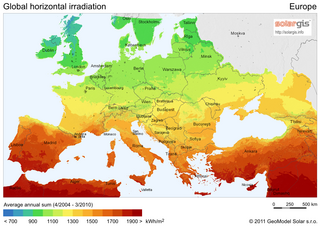
This article needs to be updated. (February 2024) |
Solar power consists of photovoltaics (PV) and solar thermal energy in the European Union (EU).
In 2010, the €2.6 billion European solar heating sectors consisted of small and medium-sized businesses, generated 17.3 terawatt-hours (TWh) of energy, employed 33,500 workers, and created one new job for every 80 kW of added capacity.[1]
Solar energy, the fastest-growing energy source in the EU, saw an 82% cost reduction between 2010 and 2020. Solar capacity expanded from 164.19 GW in 2021 to an estimated 259.99 GW by 2023.[2]
In 2022, four EU member states—Spain, Germany, Poland, and the Netherlands—ranked among the top 10 globally for additional solar capacity installed in the preceding year.[3]
During 2023, an additional 55.9 gigawatts (GW) of photovoltaics systems were connected to the grid in the European Union, taking cumulative capacity to 263 GW.[4] 2023 also saw a record high 9.1% of EU electricity generation coming from solar power.[5]
- ^ [Solar Thermal Markets in Europe Trends and Market Statistics 2010], European Solar Thermal Industry Federation (ESTIF) June 2011 p. 14-15, Figure Capacity in operation 2010/2020
- ^ Cite error: The named reference
:0was invoked but never defined (see the help page). - ^ "The world's solar rooftop power doubled in 2022, new report reveals". euronews. 13 June 2023. Retrieved 14 March 2024.
- ^ "New report: EU solar reaches record heights of 56 GW in 2023 but warns of clouds on the horizon". SolarPower Europe. 12 December 2023. Retrieved 5 March 2024.
- ^ "European Electricity Review 2024". Ember. 12 December 2024. Retrieved 7 February 2024.